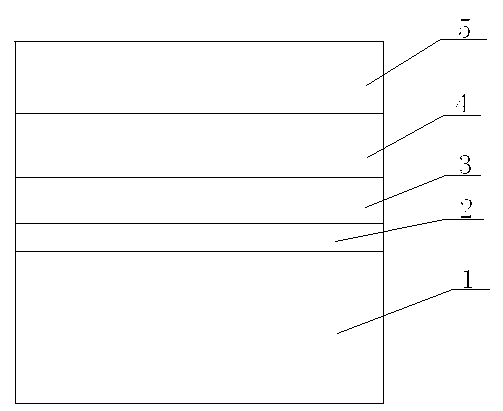Crystalline silicon solar cell antireflection film
A technology of solar cells and anti-reflection coatings, applied in circuits, electrical components, semiconductor devices, etc., can solve the problems of low photoelectric conversion efficiency and multi-reflection loss of crystalline silicon solar cells, and achieve good chemical stability, low absorption rate, The effect of good passivation effect
- Summary
- Abstract
- Description
- Claims
- Application Information
AI Technical Summary
Problems solved by technology
Method used
Image
Examples
Embodiment Construction
[0020] The present invention will be further described below in conjunction with the accompanying drawings and specific embodiments.
[0021] Such as figure 1 shown. An anti-reflection film for a crystalline silicon solar cell, in which a silicon nitride oxide film layer 2, a titanium dioxide film layer 3, a silicon nitride film layer 4 and a silicon dioxide film layer 5 are sequentially deposited on the surface of a silicon wafer 1 of the solar cell. The silicon nitride oxide film layer 2 used in the present invention has a thickness of 8 nm and a refractive index of 2.16; a titanium dioxide film layer 3 has a thickness of 18 nm and a refractive index of 2.02; a silicon nitride film layer 4 has a thickness of 30 nm and a refractive index of 1.85; The silicon dioxide film layer 5 has a thickness of 45 nm and a refractive index of 1.48.
PUM
 Login to View More
Login to View More Abstract
Description
Claims
Application Information
 Login to View More
Login to View More - R&D
- Intellectual Property
- Life Sciences
- Materials
- Tech Scout
- Unparalleled Data Quality
- Higher Quality Content
- 60% Fewer Hallucinations
Browse by: Latest US Patents, China's latest patents, Technical Efficacy Thesaurus, Application Domain, Technology Topic, Popular Technical Reports.
© 2025 PatSnap. All rights reserved.Legal|Privacy policy|Modern Slavery Act Transparency Statement|Sitemap|About US| Contact US: help@patsnap.com

